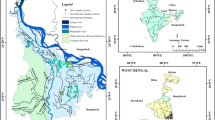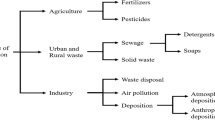Abstract
This study focused on the evaluation of leaching behaviours for arsenic and heavy metals (Cd, Cu, Ni, Pb and Zn) in soils and tailings contaminated by mining activities. Ten representative mine soils were taken at four representative metal mines in Korea. To evaluate the leaching characteristics of the samples, eight extraction methods were adapted namely 0.1 M HCl, 0.5 M HCl, 1.0 M HCl, 3.0 M HCl, Korean Standard Leaching Procedure for waste materials (KSLP), Synthetic Precipitation Leaching Procedure (SPLP), Toxicity Characteristic Leaching Procedure (TCLP) and aqua regia extraction (AR) methods. In order to compare element concentrations as extraction methods, relative extraction ratios (RERs, %), defined as element concentration extracted by the individual leaching method divided by that extracted by aqua regia based on USEPA method 3050B, were calculated. Although the RER values can vary upon sample types and elements, they increase with increasing ionic strength of each extracting solution. Thus, the RER for arsenic and heavy metals in the samples increased in the order of KSLP < SPLP < TCLP < 0.1 M HCl < 0.5 M HCl < 1.0 M HCl < 3.0 M HCl. In the same extraction method, the RER values for Cd and Zn were relatively higher than those for As, Cu, Ni and Pb. This may be due to differences in geochemical behaviour of each element, namely high solubility of Cd and Zn and low solubility of As, Cu, Ni and Pb in surface environment. Thus, the extraction results can give important information on the degree and extent of arsenic and heavy metal dispersion in the surface environment.


Similar content being viewed by others
References
Adriano, D. C. (2001). Trace elements in the terrestrial environment-biogeochemistry, bioavailability, and risks of metals (2nd ed.). New York: Springer.
Al-Abed, S. R., Jegadeesan, G., Purandare, J., & Allen, D. (2008). Leaching behavior of mineral processing waste: Comparison of batch and column investigation. Journal of Hazardous Materials, 153(3), 1088–1092.
Alloway, B. J. (1995). Heavy metals in soils (2nd ed.). London: Blackie Academic and Professional.
Bhattacharya, P., Mukherjee, A. B., Jacks, G., & Nordqvist, S. (2002). Metal contamination at a wood preservation site: Characterisation and experimental studies on remediation. Science of the Total Environment, 290, 165–180.
Boggess, W., & Wixson, B. G. (1979). Lead in the environment. New York: Castle House Publications Ltd.
Bowen, H. J. M. (1979). Environmental chemistry of the elements. New York: Academic Press.
Cappuyns, V., & Swennen, R. (2008). “Acid extractable” metal concentrations in solid matrices: A comparison and evaluation of operationally defined extraction procedures and leaching tests. Talanta, 75(5), 1338–1347.
Davies, B. E., & Thornton, I. (1989). Environmental pathways of lead into food: A review. ILZRO Critical Review Series, North Carolina: ILZRO.
Fergusson, J. E. (1991). The heavy elements: Chemistry, environmental impact and health effects. Oxford: Pergamon Press.
Jung, M. C. (2008). Contamination by Cd, Cu, Pb, and Zn in mine wastes from abandoned metal mines classified as mineralization types in Korea. Environmental Geochemistry and Health, 30(2), 205–217.
Jung, M. C., & Thornton, I. (1997). Environmental contamination and seasonal variation of metals in soils, plants and waters in the paddy fields around a Pb–Zn mine in Korea. Science of the Total Environment, 198(2), 105–121.
Jung, M. C., Thornton, I., & Chon, H.-T. (2002). Arsenic, Sb and Bi contamination of soils, plants, waters and sediments in the vicinity of the Dalsung Cu-W mine in Korea. Science of the Total Environment, 295, 81–89.
Kabata-Pendias, A., & Mukherjee, A. B. (2007). Trace elements from soils to human. Berlin, Germany: Springer-Verlag.
Kabata-Pendias, A., & Pendias, H. (2000). Trace elements in soils and plants. New York, USA: CRC Press Inc.
Korea Ministry of Environment (KMOE). (2005). Detailed survey for soil and water contamination in abandoned metal mines in Korea. Seoul: KMOE.
Korea Ministry of Environment (KMOE). (2006). Waste management act on Korea. Ministry of Environment. Seoul: KMOE.
Korea Ministry of Environment (KMOE). (2007). Reconnaissance survey for soil and water contamination in abandoned metal mines in Korea. Seoul: KMOE.
Lee, J. S., Chon, H. T., & Jung, M. C. (2005). Toxic risk assessment and environmental contamination of heavy metals around abandoned metal mine sites in Korea. Key Engineering Materials, 227–229, 542–547.
Moncur, M. C., Ptacek, C. J., Blowes, D. W., & Jambor, J. L. (2005). Release, transport ans attenuation of metals from an old tailings impoundment. Applied Geochemistry, 20(3), 639–659.
Peters, R. W. (1999). Chelant extraction of heavy metals from contaminated soils. Journal of Hazardous Materials, 66, 151–210.
Ure, A. M. (1995). Methods of analysis for heavy metals in soils. In B. J. Alloway (Ed.), Heavy metals in soils (2nd ed.). London: Blackie Academic and Professional.
US EPA. (1997). Test method for evaluating solid waste, physical/chemical method (SW846) (3rd ed.). Washington, DC: Government printing office.
Yang, J.-S., Lee, J. Y., Baek, K., Kwon, T.-S., & Choi, J. (2009). Extraction behavior of As, Pb, and Zn from mine tailings with acid and base solution. Journal of Hazardous Materials, 171, 443–451.
Acknowledgments
This study was fully supported by a grant from the Mine Reclamation Corporation (MIRECO) in Korea.
Author information
Authors and Affiliations
Corresponding author
Rights and permissions
About this article
Cite this article
Son, H.O., Jung, M.C. Relative extraction ratio (RER) for arsenic and heavy metals in soils and tailings from various metal mines, Korea. Environ Geochem Health 33 (Suppl 1), 121–132 (2011). https://doi.org/10.1007/s10653-010-9356-0
Received:
Accepted:
Published:
Issue Date:
DOI: https://doi.org/10.1007/s10653-010-9356-0




